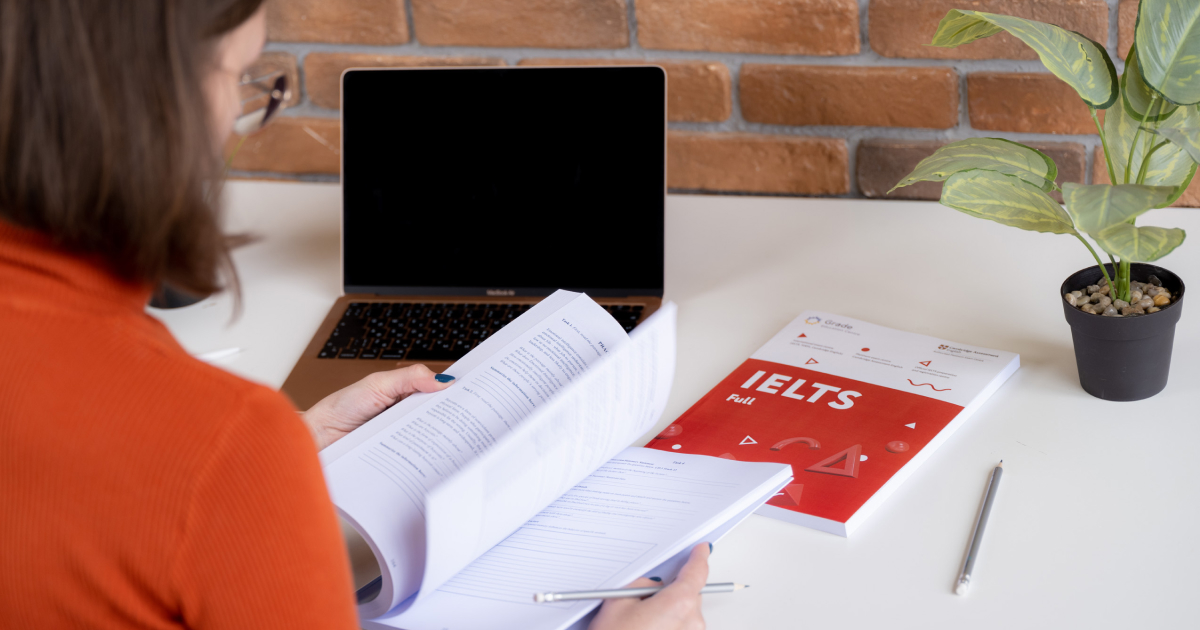
Brainstorming ideas for IELTS essays: how to help your students
- Writing
- IELTS
- Tips & Strategies

24.10.2024
IELTS (the International English Language Testing System) is often a gateway to academic and professional opportunities in English-speaking countries.
For teachers, preparing students for this high-stakes exam can seem daunting.
Having a solid plan in place, you can equip your students with the skills and strategies they need to succeed on the exam.
There are two main IELTS tests available: IELTS Academic and IELTS General Training.
First of all, a teacher must find out a student's goal in order to understand which test to start preparing for.
Let's say that a student wants to get a higher education abroad or a job in an international organization in an English-speaking country.
In that case, they need to prepare for IELTS Academic, which determines whether students have the level of English language proficiency required for academic higher education and assesses whether students are ready to start studying.
The IELTS General Training Test is used for non-academic purposes.
Preparation for this test is essential for those students who aim to open the door to a new brighter future, whether by emigrating to an English-speaking country or advancing their careers in an international company within their own country.

Take a crash course in teaching IELTS reading
Join our courseOnce you've helped a student choose the right IELTS test they need to take, familiarize them with the test format, sections, and types of questions.
The IELTS Academic and General Training tests both consist of four parts and test four English proficiency skills: listening, reading, writing and speaking.
However, reading and writing tasks are different and we will elaborate on these differences later in the article.
Before diving into preparation and breaking down each part and the tasks, briefly familiarize students with the types of questions they may encounter in each part of the test (e.g., multiple choice, gap fill, essay writing, interviews), as well as the time allotted for the Listening, Reading, Writing and Speaking tests.

The IELTS Listening test consists of 4 parts with 40 questions in total and takes 30 minutes, in the paper-based test students have an additional 10 minutes to transfer their answers, while in the computer-delivered test, they are given 2 minutes to check their answers.
The content, identical for both Academic and General Training candidates, includes general listening situations in the first two parts and academic contexts in the latter two.
Recordings played only once, cover dialogues, speeches, conversations, and lectures, with each correct answer earning 1 mark.
The IELTS Reading test lasts 60 minutes for both paper-based and computer-delivered formats, with no extra time to transfer answers.
Both Academic and General Training tests include 40 questions, but while the Academic test features three passages from books, journals, and newspapers on academic topics, the General Training test focuses on everyday topics with texts from notices, ads, and official documents.
Each correct answer is awarded 1 mark.

Common mistakes students make in the IELTS Listening section
Read nowBoth the Academic and General Training IELTS Writing tests consist of two tasks, with a total time of 60 minutes.
In both versions, it’s recommended to spend 20 minutes on Task 1 and 40 minutes on Task 2.
In the Academic test, Task 1 requires students to write a descriptive report (at least 150 words) based on graphic or pictorial input (e.g., graphs, charts, diagrams).
In the General Training test, Task 1 involves writing a formal or informal letter in response to a given situation.
Task 2 is the same for both types of the test and involves writing a 250-word essay expressing students’ own ideas based on a task.
7 tips for teaching IELTS writing
The IELTS Speaking test is divided into three parts.
In Part 1 (4-5 minutes), an examiner interviews a candidate with questions on familiar topics.
In Part 2 (3-4 minutes), a candidate speaks for 1-2 minutes on a given topic, with 1 minute to prepare.
In Part 3 (4-5 minutes), a discussion follows, linked to the Part 2 topic, where the candidate is encouraged to develop more abstract and academic language.
To help a student reach point B, you first need to understand what their point A is.
After briefly familiarizing your learner with the test structure, conduct a mock IELTS test or diagnostic assessment to check their performance, strengths, and areas that need improvement.
Knowing where a student stands at the beginning of their journey to prepare for the important test helps pinpoint areas needing the most improvement.
Once weaknesses are identified, you can set realistic goals based on their current level and create a personalized study plan that addresses their specific needs.

Each section of the IELTS exam tests specific skills, so it's important to focus on improving those key areas.
For Listening, introduce students to different English accents and speaking speeds.
Recordings are played once only that’s why it’s vital to practice predicting the content.
Explain to your students how important it is to read every question carefully before listening and encourage them to underline keywords in questions, so they can predict the content or type of listening text.
It's always helpful to do the listening tasks from previous test papers, however, listening to the radio and watching English TV movies or podcasts can help boost listening skills as well.
Students should remember that it isn’t crucial to understand every word, it’s necessary for them to highlight the main points of what is being said.
When preparing for the Reading part of the test, teach your student to skim and scan effectively.
Skimming passages is needed for a general understanding of a text.
When students learn to scan passages effectively, they will easily be able to find keywords, synonyms or parallel expressions in the text more easily.
And in order to know which keywords to highlight, students must learn to read questions carefully and find keywords in them.
During listening, it is not necessary to know every word in a text, the main thing is to understand the general meaning and highlight the words in the text that provide the required information.

How to overcome the main challenges of IELTS reading?
Find outThe main focus during preparation for Writing should be on structuring responses and ensuring grammatical accuracy.
The IELTS Writing test includes two tasks, each with distinct topics.
It is important to familiarize students with the nuances of both formal and informal writing styles and to practice writing various types of essays, letters, or how to describe infographics so that a candidate’s writing is coherent and cohesive.
To ensure your student’s written work is evaluated positively, it is worth focusing on enhancing their vocabulary and using grammatical structures correctly.
During the Speaking part, students will be evaluated on the following criteria: fluency and coherence, vocabulary and variety of lexical units, colocations and idioms used, accurate and correct use of a wide range of grammatical structures, pronunciation.
To help your student successfully pass the communication part make sure that they relax and talk fluently and naturally.
Ask your learners a range of questions to teach them communicate opinions and information on everyday topics and common experiences.
The wider a candidate's range of vocabulary, the easier it is for them to speak at length on a given topic using appropriate language.
If a student’s vocabulary is limited, it is a teacher's task to enhance it by studying words and expressions in context.
A student has to learn to answer a specific question without moving on to another topic, organize their ideas coherently, express and justify their opinions, analyze, discuss and speculate about issues.

Time management is key in the IELTS exam.
Exams are terrible for a number of reasons, but the most frustrating part is not completing them on time.
Poor time management during exams can result in a student not being able to answer all the questions due to lack of time, misreading a question they just answered, or having their answer sheet taken away by the invigilator before a student can finish a sentence.
Help your students practice completing assignments within the time limits for each section.
For example, they should know how to adjust the pace of reading and allocate time to give answers to questions, determine how much time your student spends on each written task and practice writing essays, letters or describing visual inputs on time, have a student listen to the recordings without rewinding, conduct speaking practice in terms of time.
During exam preparation, engage students in real-time mock tests.
Conducting mock tests will help your students understand what questions will appear on the exam and how much time they need to answer them.
Moreover, simulating real exam conditions will help build their confidence.
IELTS Essay Types and Structure
Providing constructive feedback, especially on practical tasks such as writing and speaking, is crucial.
Assess your students' progress regularly to track improvement and adjust a learning plan as needed.
Give your students detailed feedback on how they can improve their grammar, vocabulary and overall communication skills and coherence.
Regular progress checks will help ensure future test takers are on track to achieve their goals.
Just like time management, managing emotions is crucial for IELTS success.
Many students feel nervous about the IELTS exam, so the teacher's task is to help their students develop confidence by simulating the exam environment and offering tips on how to stay calm under pressure.
By simulating test conditions, familiarizing students with the test format and sharing personal tips from teacher’s own experience can ease their anxiety.
Remind them that preparation and practice will lead to success.
Clear explanations of the test’s organizational aspects will also help prevent confusion and reduce fear.
The process of preparing students for the IELTS exam can be challenging, but rewarding.
By focusing on your student's specific needs, focusing on weaknesses, using authentic practice materials, and developing essential skills, you'll help your students prepare for the exam with confidence and readiness.
Myroslava Khmelenko
Author
Teacher of General English
Comments
Leave your comment